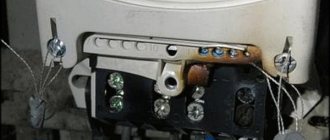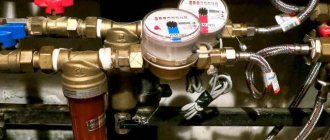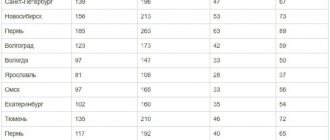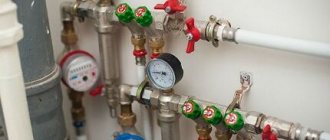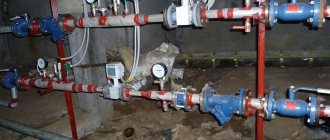Today we will talk about metering devices and which electric meter is best to install in an apartment. Theoretically, the meter is the responsibility of the company that sells you electricity, but in practice, this issue has to be resolved by the residents of the house or apartment. You are required to have a metering device and replace it as needed, for example, if it is old and does not meet modern requirements.
And here a big question arises - how to choose an electric meter for an apartment? If you can’t count them, like mosquitoes in summer. Offhand, any experienced electrician will name you a couple of dozen manufacturing companies from Russia and neighboring fraternal republics.
But even the coolest of us will not remember all the types, because there are more than four hundred names. And this is without imported electricity meters from Europe. In short, your eyes widen and your head spins if you need to buy an electric meter for an apartment, and even the price is a secondary issue.
So, we decided to write instructions on how to choose an electricity meter for an apartment or house.
Electricity meter for an apartment - design and characteristics
To understand how to choose, you need to know what we are choosing. As the rabbit in Winnie the Pooh said: “I come in different forms!”, the same picture applies to counters.
Induction and electronic
First of all, metering devices are divided by design.
Induction counter
was invented a long time ago and until recently only it was used. This is a familiar disk drive that is located on the site or right in the apartment. Inside such a device there are two magnetic coils, current and voltage. Their magnetic field rotates a disk connected to a counting mechanism, which takes into account the kilowatts used.
A distinctive feature of the induction meter is its reliability and long service life. According to the passport, at least 15 years, but in fact, such “electricity accountants” have been quietly working for 30-50 years. But the accuracy of the measurement is rather weak, as they say, only large fish are caught, and weak loads are missed.
Electronic counter
measures flow directly and appeared not so long ago. There are no moving measuring parts in it; consumption data is shown on the indicator board. An electronic recorder can store consumption figures and transmit them, for example, in automated smart home systems.
New devices can calculate energy consumption at several tariffs with high accuracy. Which, by the way, can be increased if you replace the microcircuit. Everything is taken into account, even the most minimal load from equipment in sleep mode.
Manufacturers promise that they will work for at least 10-15 years, but so far none have reached this age; they appeared only recently. As for reliability, we can say that the electronics can be glitchy, but in general, if done well, it works just as well.
Single-phase or three-phase meter for an apartment
Since electrical networks are single-phase, with a voltage rating of 220 V, and three-phase, with a voltage of 380 V, meters are produced in different types.
Most apartment residents have a single-phase electric meter. Our household electrical networks are designed for 220 Volts, as are home electrical appliances. Is a three-phase meter needed in an apartment with a single-phase network? More likely no than yes. Theoretically, if installed, it will keep track of electricity correctly. But the energy sales organization will simply refuse to register it.
A three-phase meter is usually needed in a private home. Much of the equipment there (boilers, water heaters, electric motors) runs on a three-phase network with a voltage of 380 V. There is also a 220-volt electricity meter in the house. He calculates the consumption of a single-phase network, that is, he is responsible for lighting and working irons, kettles, washing machines, TVs, etc.
Advice!
For an apartment, it is enough to buy a single-phase electronic electricity meter.
Typeit NEVA MT 324 1.0 A OS 26 (4 tariffs) 5(60) A
One of the most popular counters in Moscow. The device Typeit NEVA MT 324 is a multi-tariff three-phase device, suitable for installation in commercial, industrial, agricultural enterprises, apartments and private houses. The purpose of the meter is to measure and record the consumption of active or reactive energy in 3-4 phase networks.
The average time to failure is 210 thousand hours; in practice, the period is usually longer. The warranty from the date of manufacture is 7 years, the calibration intervals are 16 years, after which, provided there are no violations, the device can be used further.
Advantages:
- multifunctionality;
- maximum customizability;
- possibility of recording readings, programming according to tariffs;
- fixing current values without access to the power grid;
- durability.
Flaws:
- there are no shortcomings.
What kind of meter is needed for the apartment - multi-tariff or single-tariff
Previously, all metering devices were induction and single-tariff. With the advent of electronic ones, it became possible to count consumed electricity at several tariffs - two, three or more.
A multi-tariff registrar calculates consumption by time, for example, a two-tariff one for the day zone - from 7 am to 11 pm and for the night zone - from 11 pm to 7 am.
Daytime energy is more expensive, nighttime energy is cheaper, therefore, you can schedule the operation of energy-intensive equipment at night. Start washing there or turn on the heater. Profitable? Yes, but here's the story. The difference in day and night tariffs is large in some places, and practically none in others, but a multi-tariff meter is always more expensive than a single-tariff meter.
Therefore, before choosing to pay at several rates, estimate your monthly expenses and break them down into day/night periods. And then calculate according to one tariff. If the savings are half of the single-tariff payment or at least a third, then it makes sense to install a multi-tariff device. It will pay for itself and save your money.
If the difference is 100-200 rubles, then there is no point in bothering with multi-tariff payments. The equipment will not pay for itself soon and the savings are purely symbolic. In this case, it is better to think about smart energy management.
A multi-tariff electricity meter for a home must also be selected based on consumption and taking into account the equipment with powerful electrical equipment. If a water heater or partial electric heating is working, then it is more profitable to use them as much as possible at a cheap nightly rate.
INCOTEX Mercury 200.02 (2 tariffs) 5(60) A
Ideal choice for meter replacement. INCOTEX Mercury 200.02 devices are used for multi-tariff metering and measuring the parameters of two-wire networks with alternating current. The information is recorded and stored, transmitted to ASKUE data collection centers.
Installation - strictly indoors, in a panel or cabinet. Accounting, storage, measurement, data output to LCD, transmission via interfaces - automated operations. Data recording indicating the amount to be paid is done for each tariff separately. You can program the tariff, create monthly schedules taking into account weekends and working days. Each month will be programmed on individual schedules.
Advantages:
- accurate instant measurements;
- multifunctional pulse output;
- absence of magnetically sensitive elements;
- event logging;
- the presence of an auto-self-diagnosis system with an error indicator;
- displaying information on the LCD even when the power is off;
- compact dimensions.
Flaws:
- the price is above average.
How to choose an electricity meter for your home according to accuracy class
Electric meters differ not only in design and number of tariffs, but also in accuracy class. Any device has a measurement error. The accuracy class is the maximum error.
According to modern requirements, an electric meter in an apartment or house must have an accuracy class of 2.0 or lower.
That is why they are forced to change old induction devices, which have an accuracy class of 2.5%. What's the practical point? The higher the error rate, the more the device will miss a weak load and will not count it. For example, many home electrical appliances are in standby or sleep mode part of the time. The energy consumption is small, but it is still there. A meter with a lower error (1-2%) will calculate such consumption, but a meter with a high error (2.5%) will simply not notice it. This is beneficial for the consumer, but not at all beneficial for energy sales. The undercount turns out to be quite significant.
On the other hand, if you “plug in” a device with an accuracy class of 0.2% instead of two, you will create a holiday for energy sales and a problem for yourself. Your accurate meter will “give” inflated consumption readings. In essence, you will be paying for yourself and your neighbor.
Our advice!
Take an electric meter for your house or apartment with an accuracy class of 2.0. The requirements indicate an “upper limit” of error - use this. Send everyone who is forced to install the device with greater accuracy to read the rules.
Buy an electricity meter for your apartment on a din rail or with bolts
The meters have one more difference - the method of fastening. Manufacturers produce equipment in two versions:
- with DIN rail mounting
- with bolt mounting
DIN rail mounting is most often used in boxes and electrical panels inside buildings and premises. In apartment buildings, the registrar is located on the site or right in the apartment. The installation diagram can be different, a separate meter in the box and separate circuit breakers and RCDs, or all together on one panel. When installing together, it is better to take a modular meter on a DIN rail.
Bolt mounting is more often used in outdoor switchboards, for example, in input and distribution devices of private houses. Bolted fastening secures the equipment more reliably and protects against shifts and loss of contact.
Most meters are installed inside houses, either in the city or outside the city. According to operating rules, devices must operate in a heated room or in a heated panel. DIN rail models are the best option for installation inside buildings; they are easy to install and dismantle.
What to do if the house is old and the meter is bolted, but you want a new modular one? Take it and tell your comrades from the energy sales that you want mounting on a rail. Fixing the DIN rail into an old panel is not difficult at all, it takes about 5 minutes.
Important point!
In fact, the energy supply must seal the new meter and register it. That is, replacing old equipment with new can be done by any qualified electrician with an access group of at least third.
Who should pay for the installation of metering devices?
According to Art.
13 part 5 of the Energy Saving Law, owners are required to ensure that their homes are equipped with meters for water, natural gas, heat, and electricity, as well as putting the installed meters into operation. Also, despite the fact that the electric meter is located on the landing, it takes into account the electricity consumption of an individual apartment, and thus belongs to the property of the owner (tenant) of the apartment. Consequently, the owner must bear the burden of maintaining the property he owns (Article 210 of the Civil Code of the Russian Federation). Accordingly, the owner bears the costs of replacing a metering device that does not meet the requirements.
If the owner is not able to pay for the metering device and its installation at a time, then the resource supplying organization is obliged to provide payment in installments for a period of up to 5 years. The interest on the loan is set at the refinancing rate of the Central Bank of the Russian Federation. In this case, it is necessary to conclude an installment payment agreement.
Owners who have not fulfilled their obligations to equip their housing with metering devices for used energy resources within the prescribed period must pay resource-supplying organizations the costs of installing metering devices and their delivery to the installation sites of metering devices. In case of refusal to pay expenses voluntarily, the owners must also pay the expenses incurred by these organizations in connection with the need for forced collection.
Many resource supplying organizations abuse their rights and charge fees for sealing metering devices. If the owner refuses to pay for such a service, organizations refuse to register metering devices, which means they do not take readings from them. However, imposing a sealing service is illegal, and it is also illegal to charge a fee for it.
As an example, consider the decision of the Abakan City Court in 2012.
From the case materials. The Office of Rospotrebnadzor for the Republic of Khakassia, acting in the interests of an indefinite number of consumers, filed a lawsuit against LLC ZHEUK "Kh." on the protection of consumer rights with a requirement to recognize the actions of LLC ZHEUK "H." as illegal. for collection of payment for sealing of metering devices (meters), payment of associated transportation costs.
At the court hearing, the representative of the plaintiff, Kh., explained to the court that the defendant, being obliged to seal installed water consumption meters, illegally charges for this, as well as for transportation costs associated with sealing the meters. The representative asks the court to satisfy the claim, explaining that the court's decision will serve as the basis for recalculating the service for consumers.
After listening to the explanations of the representatives of the parties and studying the case materials in their entirety, the court came to the following conclusion.
From the copy of the receipt submitted to the case file it follows that LLC ZHEUK "H." accepted 370 rubles from citizen M. for sealing two meters and 70 rubles. transportation costs, only 440 rubles.
By virtue of paragraph 1 of Art. 16 of the Law “On the Protection of Consumer Rights”, contract terms that infringe on consumer rights in comparison with the rules established by laws or other legal acts of the Russian Federation in the field of consumer rights protection are declared invalid.
According to Part 2 of this article of the law, it is prohibited to condition the acquisition of some goods (works, services) on the mandatory acquisition of other goods (works, services).
RF PP dated 08/13/2006 No. 491 “On approval of the rules for the maintenance of common property in an apartment building and the rules for changing the amount of payment for the maintenance and repair of residential premises in the case of the provision of services and performance of work on the management, maintenance and repair of common property in an apartment building of improper quality” quality and (or) with interruptions exceeding the established duration" it is determined that the composition of the common property in an apartment building includes in-house engineering systems of cold and hot water supply, consisting of risers, branches from the risers to the first disconnecting device located on the branches from the risers indicated disconnecting devices, collective (common house) cold and hot water metering devices, the first shut-off and control valves on the branches of the intra-apartment wiring from the risers, as well as mechanical, electrical and other equipment located on these networks.
Art. 157 of the Housing Code of the Russian Federation determines that the amount of payment for utilities is calculated based on the volume of consumed utilities, determined by the readings of metering devices, and in their absence, based on consumption standards.
Since metering devices already have a verification seal when sold, in fact, when the management company seals the metering devices, the connection between individual metering devices and the water supply system is sealed.
Subclause “d” of clause 52 of the Rules stipulates that the consumer is obliged to ensure the safety of seals on collective (community) and individual metering devices and distributors installed in residential premises. However, the Rules do not provide for the right to install seals at the expense of consumer citizens. The obligation to seal metering devices or other sealing, including the places where individual metering devices are connected to common property in an apartment building, is not provided for by either the specified regulatory act or other legal acts of the Russian Federation. The court decided to satisfy the claim of the Office of Rospotrebnadzor for the Republic of Khakassia in defense of an unspecified number of persons.
In connection with the above, paid sealing of metering devices, as well as collection of transportation costs, are imposed services that are not based on the law. These services are the responsibility of the management company.
Federal Law No. 261-FZ dated November 28, 2009 “On energy saving and increasing energy efficiency and on introducing amendments to certain legislative acts of the Russian Federation” (Part 5, Article 13) obliges the owners of residential buildings to ensure that their houses are equipped with water metering devices, and also put the installed metering devices into operation. Commissioning of an installed water meter, according to this law, does not oblige the citizen to obtain permission to put the meter into operation, but establishes the obligation to operate the meter, ensure its proper safety and timely replacement.
If the apartment is municipal property (not privatized), the owner is an authorized local government body, and the citizen is the tenant. Thus, the local government body must install and replace metering devices accordingly.
Let us consider as an example the decision of the Obluchensky District Court of the Jewish Autonomous Region dated 08/09/2012.
From the case materials. A.S. Tishin filed a claim with the Obluchensky District Court of the Jewish Autonomous Okrug against the administration of the municipality for the obligation to install individual metering devices for the energy resources used, to recover material damage and compensation for moral damage. The plaintiff motivated his demands by the fact that in the apartment where he lives, from the moment of moving in, there are no individual meters for metering consumed energy resources; the energy supply organization calculates for the consumption of energy resources based on the size of the regional standard. A.S. Tishin believes that he consumes much less energy resources because he lives alone and has only a TV and three light bulbs in the house. The plaintiff also considers the consumption of hot and cold water to be incommensurate with the bills issued to him. To determine the actual consumption of energy resources, he is forced to install individual meters for accounting for consumed energy resources. The apartment in which he lives is municipally owned, and the plaintiff uses it on the basis of a social rental agreement concluded between him and the municipal administration. In January 2010, he applied to the administration to install an individual meter for electricity consumption, but his application was denied due to the administration’s lack of funds. A.S. Tishin believes that the district administration ignored his request. In addition, the plaintiff does not have the financial ability to install meters on his own. The failure of the municipal administration to fulfill its duties led to the fact that OJSC “” collected the resulting debt from the plaintiff.
The plaintiff regularly pays utility bills, but pays a smaller amount of the bill, because is unable to pay the full amount. He believes that throughout the entire period of living in the apartment he pays more for energy resources than he actually consumes, in addition, he is constantly worried that he will be evicted from the apartment; his health has worsened over two and a half years. The plaintiff asks the court to oblige the municipal administration to install individual metering devices for energy resources used; recover from the administration of the municipality material damage and compensation for moral damage.
The court, after hearing the explanations of the parties and examining the written materials of the case, came to the conclusion that the claims of Tishin A.S. are subject to partial satisfaction for the following reasons.
In accordance with Art. 210 of the Civil Code of the Russian Federation, the owner bears the burden of maintaining the property belonging to him, unless otherwise provided by law or contract. Another regulation, according to which the burden of maintaining energy networks, mechanical, electrical, sanitary and other equipment that are an integral part of the residential premises, is assigned to the owner of the residential premises, is provided for by the Housing Code of the Russian Federation. Part 3 Art. 30 of the RF Housing Code obliges the owner of a residential premises to bear the burden of its maintenance.
Part 2 of Art. 676 of the Civil Code of the Russian Federation stipulates that the landlord is obliged to carry out proper operation of the residential building in which the rented residential premises are located, to provide or ensure the provision of necessary utilities to the tenant for a fee, to ensure the repair of the common property of the apartment building and devices for the provision of public utilities located in the residential building indoors.
Thus, the administration of the municipality as the owner of the residential premises in which plaintiff A.S. lives. Tishin, the responsibility should be assigned to provide the apartment with metering devices for used water, electrical energy, as well as putting the installed metering devices into operation.
Thus, the court came to the conclusion that the claims of A.S. Silence regarding the obligation of the municipal administration to install an electrical energy meter in the apartment must be satisfied.
It is important to note that in accordance with Art. 158 of the Housing Code of the Russian Federation, the owner of premises in an apartment building is obliged to bear the costs of maintaining the premises belonging to him, as well as to participate in the costs of maintaining common property in an apartment building in proportion to his share in the right of common ownership of this property by paying a fee for the maintenance and repair of residential premises. That is, apartment owners in an apartment building must install communal meters at their own expense.
Electricity meter for apartment - verification date
Let's start with the official part. The PUE states that a single-phase apartment meter must have “seals with the stamp of the state verifier... no more than 2 years old,” and a three-phase meter in a private house must have state verification seals “not older than 12 months.”
Verification is performed at the factory after assembly of the device. The corresponding stamp with the date is placed in the passport and on the meter seal. Theoretically, stores should track the “expiration date” by verification, but in practice this is not done everywhere. That is, you can buy an electricity meter for an apartment or house with an expired verification date. And it will not be registered without a new verification. In addition, you will be penalized for “lack of a metering device” from the energy supply.
Therefore, when choosing and purchasing, be sure to look at the verification date in the documents and on the meter. It must be within the specified limits, clearly legible in the passport and especially on the seal. An unclear print may “upset” the energy sales inspector. You will also be sent to check the equipment and will be punished for its absence. In general, “the second act of the Marlezon ballet.”
The online store 220pro.ru sells meters with an expiration date for verification, with clearly readable seals and correct documents. With us you get equipment that is reliable in all respects.
Who has the right to install individual metering devices?
In accordance with the Law on Energy Saving, resource supply and specialized organizations have the right to install, replace and operate metering devices.
The organization must be a member of a self-regulatory organization in construction and have an appropriate certificate of admission to this type of work. Moreover, energy resource suppliers are required to carry out activities related to the installation, replacement, and operation of metering devices for the energy resources used, the supply or transmission of which they carry out.
Monitoring compliance with obligations regarding the installation of metering devices is carried out by the Federal Antimonopoly Service and the Federal Service for Environmental, Technological and Nuclear Supervision and their territorial bodies in the constituent entities of the Russian Federation.
Which meter to choose for an apartment based on current load
Electrical equipment for flow metering is designed for different current loads. There are three ways to figure out how many amps you need.
1.
Find out how many amperes are on the input cable that is connected to the meter. This information can be obtained from an electrician at the housing office or management company.
2.
Calculate the current load on the cables in the apartment. It is better to entrust this to the electrician who installed your wiring and knows all the cables and sections.
3.
Calculate the total power of home electrical equipment in kilowatts, taking into account the reserve for the purchase of something else.
The first two methods require the help of professionals, the third is available to any apartment owner. You write down on a piece of paper the power of everything that is connected to the outlet, add it up, add a few more kilowatts in reserve and look at the total. If it is within 10 kW, a 60 Ampere meter will be enough for you. If you count more than ten in kW, take an 80 or 100A recorder.
Based on work experience, 60 Amps on a single-phase meter is enough for the eyes and ears of most apartments. Even if there is a lot of equipment, it all turns on extremely rarely, so there is no point in covering all the power.
A three-phase meter in a private house can be taken up to 100 A, if the power supply has agreed to allocate you the appropriate power for the load. The data is indicated in the house design or must be obtained from the energy supply office.
Note!
A three-phase meter for a private house can be connected either directly or through a transformer. If the current rating is 50A or not higher than 100A, the device is switched on directly. If the load exceeds a hundred amperes, then you will have to install a secondary current transformer when connecting, and power the meter through it.
Who carries out the work?
General meter for the house, IPU on the landing - the responsibility of the management company . But how does the law determine the requirements for installing a meter inside an apartment?
The order of work must be followed; if the regulations are violated, the owner of the property will be punished.
IMPORTANT! Such responsible work as installing an electrical power supply unit is performed only by qualified specialists.
They must have permission to perform services, and the owner of the property must provide access to the premises. The consumer can negotiate a convenient time with the craftsmen.
approved models are used for installation , therefore, if you want to select a device yourself, you need to consult with the electricians of the management company.
To carry out replacement work, you need to prepare documents for this work - an application for the installation of a new device, a resolution for replacement, a passport for the electric meter.
The application should indicate why the device is installed (reason for replacement), and the type of device chosen. The application should be submitted to representatives of the organization servicing the house or to the company supplying electricity.
ATTENTION! New IPUs are programmed in a special order; the program must be delivered by network company specialists. Permission for installation should be obtained from the same authority.
If the apartment is a communal apartment and the rooms are not privatized, the work will be performed by a service company, the service should be free .
Electricity meters for apartments in the store 220pro.ru
We have figured out the main characteristics and requirements for accounting equipment, let’s now look at specific models using the example of the 220pro.ru catalog. From us you can buy an electric meter for your home or apartment made in Russia and Europe.
The catalog contains single-phase and three-phase meters under the following brands:
| Mercury counters | Neva counters | Energy meters | ABB meters |
Mercury meters for an apartment or a country house
The equipment is produced by . "Mercury™" is a well-known brand, basic accuracy class 2.0. The products are of high quality, reliability and affordable price.
Single-tariff electronic meter Mercury series 201 and 202
| Counter Mercury 201.5 | Counter Mercury 201.4 | Counter Mercury 201.2 | Counter Mercury 202.5 |
The cheapest model 201.5 costs less than 1000 rubles. It is designed for a maximum current of up to 60/80A and is perfect for city apartments. The device has a 6-year warranty, and the manufacturer promises a service life of up to 30 years. In addition, the verification interval is 16 years. And this is a very important indicator. By installing a single-tariff Mercury meter, you will forget about its verification and the claims of energy sales for a decade and a half.
Multi-tariff meter Mercury for apartment series 200
| Counter Mercury 200.2 |
Such a device can calculate electricity at 4 tariffs. The maximum current of 60A will easily cover up to 10 kilowatts of home equipment load. Calibration interval 16 years, warranty 6, service life 30. Such a meter can be connected to a computer and transmit accounting data remotely. And to control the load in different tariff zones, install an RCD. So that energy-intensive equipment does not turn on autonomously during the hours of the most expensive peak load.
Three-phase meter Mercury for a private home
| Mercury 231 AM-01 | Mercury 231 AT-01 | Mercury 230 AM-01 | Mercury 230 ART-01 |
It has an accuracy class of 1.0 and a verification interval of 10 years. Single and multi-tariff meters of the 230 and 231 series are suitable for metering active energy. Devices of the 230, 234, 236 and AR series are useful for metering active, reactive and total load.
Electric meters Energomera
Produced at electrical plants of the same name. The company has been operating for more than 20 years and the products have passed the reliability test. Basic accuracy class 1.0, calibration interval 16 years, warranty 5 years and service life up to 30 years.
Single-phase single-tariff meters Energomera series CE 101
| Energy meter CE101 R5 | Energy meter CE101 S6 145M6 | Energy meter CE 101 S6 145 |
They keep track of active electricity at a maximum current of 60/100A. Designed for 220 thousand operating hours. The design with a measuring shunt ensures high accuracy and immunity of the device to electromagnetic interference. Meters of the CE 101 series are available in different housing options, both for mounting on a DIN rail and on a plane with bolts.
Multi-tariff single-phase meter Energomera CE 102
| Energy meter CE 102 MR5 |
Can measure consumption at four tariffs and transmit data. The results are stored in non-volatile memory and are not lost when the meter is de-energized. You can also take accumulated readings from the device without mains voltage. The manufacturer produces equipment in various types of housings for installation in panels with bolts or on a DIN rail. The meter is well protected from mechanical influences and attempts to “hacking data” using a magnet.
Three-phase Energomera meters for a private house
Suitable for taking into account different types of load in three-phase circuits. Active, reactive and total energy are taken into account. Designed for a current value of 60/100A, can be connected directly or through a current transformer. Calibration interval is 16 years, warranty is 4 years and service life is 30 years.
| Energy meter TsE6803V 1 M7 P31 | Energy meter TsE6803V 1 M7 P32 | Energy meter CE300 R31 145-J | Energy meter CE300 R31 043-J |
For single-tariff metering, three-phase Energomer meters of the CE300, CE302 and TsE6803V series have been developed. Bolt or DIN rail mounting, depending on enclosure type. Equipment of the CE301, 303, 304 series is suitable for multi-tariff metering.
| Energy meter CE301 R33 145-JAZ | Energy meter CE301 R33 146-JAZ | Energy meter CE301 R33 043-JAZ | Energy meter CE303 R33 745-JAZ |
Electric meters Neva
They are produced and feature a convenient body design; there are narrow rail-mounted models that are suitable for assembling modular electrical panels. Basic accuracy class 1.0, re-verification period 16 years, warranty for 5 years and service life 30 years.
Single-tariff single-phase electric meter Neva series 101-105
| NEVA 101 | NEVA 105 | NEVA 102 | NEVA 103 |
Suitable for household accounting in apartments and houses. Designed for current from 40 to 80 A. Mounted on a rail or on the surface of a panel using bolts. The equipment has durable housings and a modern design.
Three-phase meter Neva for a country house
| NEVA 301 | NEVA 306 60 | NEVA 303 | NEVA 306 100 |
For installation on a three-phase network, devices of the Neva 301, 303, 306 series for single-tariff metering are useful. They can be installed directly connected or via a transformer. The maximum current in the network is 60/100A, with a transformer connection 7.5/10A. Meter housings are designed for installation using dinrails or screws.
ABB electricity meters
| Counter ABB C11 | ABB FBU11200 counter |
Single-tariff single-phase meters ABB models C11 and FBU11200 are suitable for home metering with maximum current ratings of 40 and 80 Amps, accuracy class 1.0. Mounted on a din rail, used for modular electrical panels.
| Counter ABB FBU-11205 |
The ABB single-phase multi-tariff meter FBU-11205 is installed on a network with a load of up to 80 Amperes. Accounting is carried out at two tariffs, with storage and transmission of data via infrared.
All equipment has Russian certificates of conformity, calibration interval is 16 years, service life is 30 years, warranty is up to 5 years.
Energy meter CE 102 R5.1 145 J 5(60) A
Single-phase multi-tariff meter Energomera CE 102 with the possibility of installation on a DIN rail or in a panel. Provides the creation of accounting according to four tariffs and an additional one - emergency with the ability to broadcast the received information via optical channels and RS-485. The metering device displays the received information on the LCD display.
The meter is intended for use in residential and non-residential premises. The case is made of durable material, but does not have a high degree of protection - IP20 and is intended for closed, dry rooms.
Advantages:
- availability of standard and optical telemetry output;
- work indicator light;
- high measurement accuracy;
- A reverse stop is provided.
Flaws:
- high price.
Which electric meter is better to install in an apartment - the best option
It’s clear that you want to install the best meter, so let’s say a few words about the optimal option. On the one hand, such recommendations are the personal preferences of the electrician, on the other hand, they are based on experience in installing meters. When you install 2-3 hundred devices in a year, you recognize them, as they say, both in profile and in front.
Our choice is the recommendations of the online store 220pro.ru
Single-phase single-tariff electric meter
| Mercury 201.5 | Energy meter CE 101 R5 |
All models are electronic, data is reflected on an LCD display or an electromechanical metering device. Designed for a maximum current of 60 Amperes and a voltage of 220 Volts, accuracy class 1.0-2.0. Mounted on a DIN rail, made of plastic. The operating range for models with an LCD display is from -20 C, for meters with EMOU from -40 C. These are data from manufacturers, it has been experimentally verified that display meters are best installed in city apartments; with an electromechanical device they work normally in country houses, where In winter, the owners visit periodically.
Single-phase multi-tariff meter
| Mercury 200.2 | Energy meter CE 102 MR5 |
Models with an electronic display, mounted on a DIN rail, designed for currents up to 60 A. Accuracy class 1.0-2.0, number of tariffs 4, you can control the load through an RCD. Meters accumulate information and can transmit it to an automated accounting system. The memory is non-volatile, data and programs are protected from hacking.
Single-tariff three-phase meter
| Mercury 230 AM-01 | Mercury 230 AM-02 | Mercury 231 AM-01 | Energy meter TsE6803V |
They count active electricity in a circuit with a voltage of 380 V at one tariff, the metering device is electromechanical, the meters themselves are electronic. Accuracy class 1.0, designed for currents up to 60 or 100 A and direct connection, with DIN rail or bolt mounting. Suitable for installation in a private home, country house, garage, workshop. A mechanical metering device normally tolerates the absence of heating, but the meter must be placed either indoors or in a special cabinet, protected from precipitation and weather vagaries.
Multi-tariff three-phase electric meter
| Mercury 230 ART-01 | Mercury 230 ART-02 | Mercury 231 AT-01 | Energy meter CE 301 |
These models calculate the energy consumption in three-phase circuits in one or two directions. Accuracy class 0.5-1.0, maximum current load 60-100 Amperes. Connection both directly and via current transformers. Installation on a dinrail or in a shield with bolts. Designed to meter active energy (models 231 AT-01, CE 301) or active and reactive (230 ART-01, 230 ART-02). A multi-tariff three-phase meter can operate both autonomously and as part of an automated system.
Important!
The choice of the optimal meter model should match the recommended manufacturers from your electricity supplier. For example, Mosenergosbyt proposes to install Mercury and Energomera meters for apartments. Petroelectrosbyt prefers products (Neva meters) and Energomer. If you do not live in capital cities, the requirements may be different. Check them on the local energy sales website or at their office.
Consequences of unauthorized intervention in the operation of an electrical energy meter
The guaranteeing supplier or network organization has the right to install control seals, indicators of anti-magnetic seals, as well as other seals and devices that make it possible to determine the fact of unauthorized interference in the operation of the electrical energy metering device, as well as structures that protect the electrical energy metering device from unauthorized interference in its operation. Also, the guaranteeing supplier or network organization is obliged to notify the consumer about the consequences of unauthorized intervention in the operation of the meter.
If the fact of unauthorized intervention in the operation of an electrical energy metering device that is installed in a residential premises or other premises, but which cannot be accessed without the presence of the consumer, is revealed, the contractor recalculates the amount of the fee and sends the consumer a request for additional payment .
The fee is recalculated based on consumption standards using a coefficient of 10.
Recalculation is made for the period: from the date of the previous inspection , but no more than 3 months before the date of detection of unauthorized interference in the operation of the meter until the date of elimination of such interference .
Let's sum it up
The online store 220pro.ru offers high-quality electric meters in a wide range of Russian and European production. Everything is done according to GOST standards, with the correct documents and valid verification dates
Come in and choose your counter!
Ask what is unclear or just interesting. As they say in Odessa, “we still have something to tell you!”
If necessary, we will assemble and deliver a turnkey installation kit from the meter to the DIN rails and fasteners. We will take into account your wishes regarding price and preferences for “brands and companies”.
Call and ask! Phones

